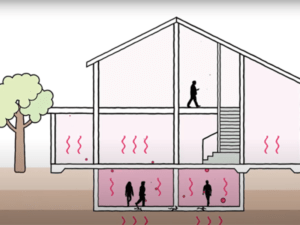Testing for Radon
What is radon?
Radon is a radioactive gas. It has no smell, no colour and no odour. It is naturally occurring in many Northern soils and can build up in your home.
Radon released from the ground can build up indoors and pose a risk to your health.
What are the health effects of radon?
Exposure to radon increases your chance of getting lung cancer. Scientists have determined that radon is the second leading cause of lung cancer, after smoking, and the primary cause of lung cancer in non-smokers. Radon causes approximately 10 per cent of all lung cancers worldwide and kills approximately 2000 people in Canada each year.
How does radon get into my home?
Radon usually comes from the soil and can enter your home through any opening that exists between the building and the ground. Floor drains, sumps, foundation cracks and joints can all act as pathways. In colder Northern climates, the migration of radon into your home is often sped up during winter months when heating systems create negative air pressures inside buildings.

Radon in British Columbia
Due to geological factors, some areas in British Columbia have naturally higher surface levels of radon than others. Many of these areas are in the Interior and Northern parts of the province.
However, indoor radon accumulation can vary widely from building to building, even in the same neighborhood. Even if you live in an area with generally lower levels of radon, it is still recommended to test your home for radon.
The interactive map displays indoor radon levels recorded in homes across BC. It also shows estimates for the increase in lung cancer risk caused by radon (both overall and for smokers).
Exposure to indoor radon
Radon can seep into your home through any opening that is in contact with the ground. It can move through cracks in the foundation, gaps around pipes, floor drains, and window casements. This can happen in both new and old homes.
Radon levels can vary greatly from house to house because the accumulation of indoor radon depends on several factors, including how much uranium is naturally in the soil of the region, how much the foundation of the home was sealed during its construction, and how much ventilation occurs in the home.
The only way to know how much radon is in your home is by testing for it.
What are my risks?
For a non-smoker, the risk of developing lung cancer when consistently exposed to high levels of radon ranges from 2 to 5 per cent, depending on the radon concentrations. The higher the radon concentrations and the longer you are exposed, the higher the risk.
The risk is much greater for smokers. A smoker’s lifetime risk of developing lung cancer when exposed to high levels of radon can range from 17 to 30 per cent.
How do I test my home?
Health Canada recommends that homes be tested for a minimum of 91 days (ideally between October and April) but preferably for 12 months. The detectors should be set up in the lowest lived-in level of your home where you spend at least 4 hours of your time each day.
Refer to the radon detector instruction package for specifics related to testing and placement of the device.
Detectors are available for purchase from Public Works for $40.00 + GST.
Reducing radon in your home
Improving radon levels in your home typically requires the installation of a “depressurization” system through a professional certified by the Canadian National Radon Proficiency Program (C-NRPP).
These systems, either passively or actively, draw radon from underneath your home and vent it outside before it can enter the house. There are a number of different types of depressurization systems, and a professional can help you decide which is best for your home and budget.
Prevention measures:
Even if your home has a low level of radon and does not require depressurization, there are still several ways to prevent radon from seeping into and accumulating in your home:
- Use sealant products to close off any opening in your home where radon can enter, such as cracks in the floors and walls of the basement
- Renovate existing basement floors, particularly earth floors
- Paint basement floors and foundation walls with two coats of paint or a sealant
- Improve the airflow in the winter by using a heat recovery ventilator
 250-997-3221
250-997-3221
